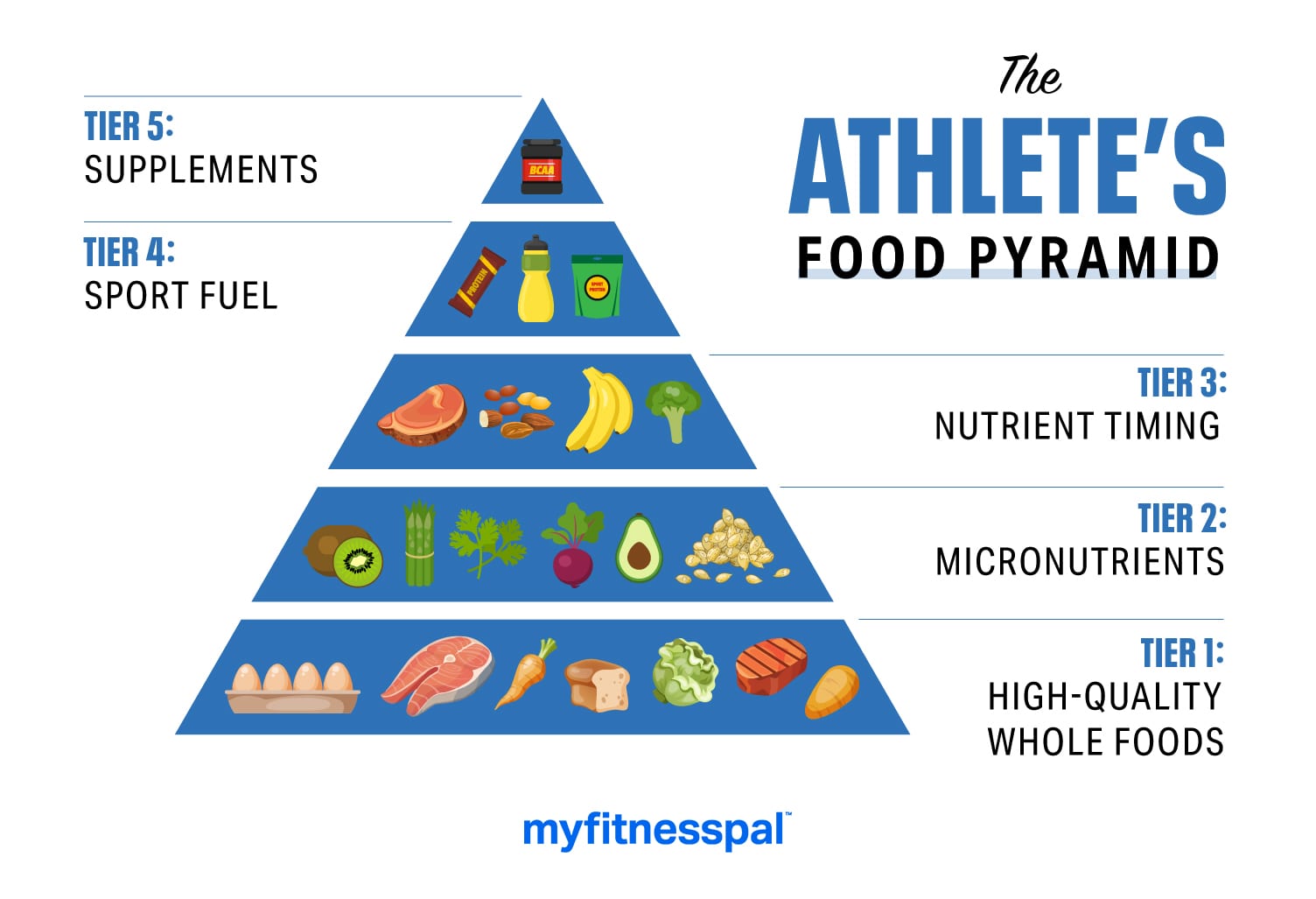
The classic food guide pyramid was created in 1992 by the USDA to provide an easy to understand visual breakdown of government eating recommendations. In recent years, the pyramid has been reworked in a variety of ways attempting to showcase and educate the general public on the basic nutrition needs of the population as a whole.
However, the original food pyramid remains the most widely recognizable visual. The pyramid does a good job showing the basic structure of a generally healthy eating pattern, but athletes (especially high-performing ones) are not the general public. Diet strategies of athletes have unique priorities that can benefit from the easy visual breakdown of a pyramid.
Athletes should think of their nutrition in terms of setting a strong foundation and progressing to the top end.

TIER 1: HIGH-QUALITY WHOLE FOODS
The base is your foundation. No top-end fueling technique is effective without a solid base made up of a healthy general diet. This includes food consumed for normal meals and snacks. Depending on individual needs, this can take many forms, but the basics are always going to be the same: Eat a variety of minimally processed, high-quality foods that provide enough energy to meet goals/demands of a healthy body and active lifestyle.
TIER 2: MICRONUTRIENTS
Micronutrients do not supply energy, but they are vital to an athlete’s health and performance capacity. These vitamins, minerals, pre/probiotics, fiber and phytonutrients (Think: antioxidants) come from a colorful variety of foods that help your body maintain metabolic processes, bone health, electrolyte balances, gut health, etc. Fill your plate with lots of fruits and vegetables for the biggest benefit, but know little things like seeds, seaweed, spices, fermented foods and herbs are largely beneficial.
TIER 3: NUTRIENT TIMING
This level of the athlete pyramid is about nutrient timing; when you consume what foods/nutrients around your training. For high-performing athletes and those looking to improve performance and/or body composition, when you eat is almost as important as what you eat.
This includes eating carbohydrates before and during workouts to provide energy; protein and carbs after training to replenish and rebuild; fats to fuel endurance efforts and fiber away from training to prevent gastric issues. Implementing nutrient timing to your intake of macros and micros helps the body better absorb and utilize the nutrients consumed for an efficient metabolism, faster performances, stronger muscles and faster recovery.
TIER 4: SPORT FUEL
Sport fuel is important to athletic performance; however, many athletes fail to limit this to the top of their food pyramid. Sport foods, such as bars, gels, drinks, chews, etc., are specifically designed to be easily digested, utilized and provide energy in a form that’s practical for physical activity. These products are useful during training but should make up a small percentage of overall caloric intake.
TIER 5: SUPPLEMENTS
The top of the athlete pyramid is for supplements. This is not necessarily less important than the base, but this top-level is useless if the other four layers aren’t there to hold it up. Supplements can give athletes a competitive edge when it comes to faster recovery, stronger muscles, faster nerve reactions, boosted immunity, enhanced energy and better oxygen delivery to working muscles. Whether it’s as simple as a daily vitamin or an advanced regime of BCAAs, beets and caffeine, supplement intake should be a bonus, not a base.
Checking in with your intake to ensure it’s structured this way helps you become a healthier person and a better athlete.
Unlock an experience that’s like having a dietitian, trainer and coach at your fingertips. Sign up for Premium for expert guidance and tools to help you reach your personal health goals.



